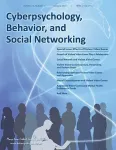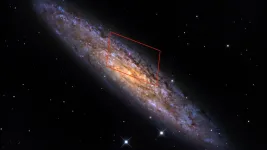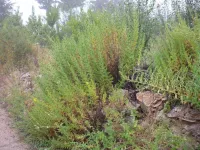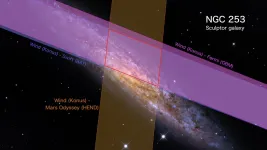Study looks at how land acquisitions affect climate change
2021-01-13
(Press-News.org) In 2007, an increase in world food prices led to a global rush for land in the form of land grabs or large-scale land acquisitions. Over the last two decades, such acquisitions have resulted in millions of hectares of land changing hands in developing nations. Although such changeover can increase the cultivation of crops needed to feed the world's growing population and spark new agricultural practices and technologies, it can also lead to environmental degradation, increased carbon emissions and threats to the livelihoods of smallholder farmers.
The socioeconomic and environmental consequences of such large-scale land acquisitions have been studied, but the effect of land grabs on carbon emissions has not, at least until now.
In a newly published study in the journal Nature Food, researchers looked at what drives large-scale land acquisitions and how the implementation of large-scale land acquisitions for agricultural development affect carbon emissions, and in turn, climate change.
"Overall, the findings suggest there is a cost-effective way to produce more food while minimizing carbon emissions from this process", said Chuan Liao, assistant professor in ASU's School of Sustainability and lead author of the study.
"It's unrealistic to say that we can't convert more land given that the world's population is growing especially in developing countries, but we still must minimize carbon emissions while pursuing agricultural development," he said.
The study researchers analyzed countries that were engaged in over 1,000 transnational, large-scale land acquisitions. They identified three distinct geographic areas where land grabs take place including coastal West Africa and the East African Rift Valley; Southeast Asia; Central-South Latin America; and Eastern Europe and western Russia.
The study showed that the quest for resources, like arable land and water, drives large-scale land acquisitions. That is, countries with low or medium-low arable land availability are usually investors, whereas those with medium-high or high arable land serve as hosts, said Liao. Likewise, countries with less water scarcity often supply land, whereas those countries with higher water scarcity invest in land.
The researchers also estimated carbon emissions from nearly 1,500 cases of large-scale land acquisitions under two agricultural-development scenarios, including business as usual and enforcement of environmental regulations.
In analyzing those emissions, the researchers found that the business-as-usual scenario, that is, clearing all vegetation from 37 million hectares of land, would emit approximately 2.26 gigatons of carbon. In contrast, implementing environmental regulations to constrain land conversion and save high-carbon-value forests would reduce emissions to 0.81 gigatons.
The study also found that enforcing environmental regulation policies does not reduce the amount of land that can be used for agricultural development at the same proportion as the reduction in carbon emission.
"Instead, we allow agricultural development on lands that have lower carbon values," explained Liao. "Our strategy is to better manage these tradeoffs because food security and carbon emission mitigation are both important."
INFORMATION:
Additional study authors include Kerstin Nolte, Institute of Economic and Cultural Geography, Leibniz University Hannover; Jonathan Sullivan and Arun Agrawal, University of Michigan; Daniel Brown, University of Washington; Jann Lay, University of Göttingen and German Institute for Global and Area Studies; and Christof Althoff, German Institute for Global and Area Studies.
The study was funded by National Science Foundation and National Aeronautics and Space Administration.
ELSE PRESS RELEASES FROM THIS DATE:
2021-01-13
Financial responsibility means managing money in a relatively sensible way by minimizing superfluous or unnecessary spending. But according to new research from the University of Notre Dame, people think they are more financially responsible than they actually are.
Even when people consistently spend their money superfluously, they still believe that they manage their money in a responsible fashion, according to " END ...
2021-01-13
New Rochelle, NY, January 13, 2021--Aggressive video games are not a risk factor for mental health problems, according to a new study of more than 3,000 youth. This study is part of a special issue on the effects of violent video games published in the peer-reviewed journal Cyberpsychology, Behavior, and Social Networking. Click here to read the issue now.
Christopher Ferguson, PhD, Stetson University, and C.K. John Wang, PhD, Nanyang Technological University, examined whether early exposure to aggressive games was predictive of anxiety depression, somatic symptoms, or ...
2021-01-13
Apart from black holes, magnetars may be the most extreme stars in the universe. With a diameter less than the length of Manhattan, they pack more mass than that of our sun, wield the largest magnetic field of any known object -- more than 10 trillion times stronger than a refrigerator magnet -- and spin on their axes every few seconds.
A type of neutron star -- the remnant of a supernova explosion -- magnetars are so highly magnetized that even modest disturbances in the magnetic field can cause bursts of X-rays that last sporadically for weeks or months.
These exotic, compact stars are also thought to be the source of some types of short gamma ray bursts (GRBs): bright flashes of highly energetic radiation that have ...
2021-01-13
Primary amoebic meningoencephalitis (PAM), a deadly disease caused by the "brain-eating amoeba" Naegleria fowleri, is becoming more common in some areas of the world, and it has no effective treatment. Now, researchers reporting in ACS Chemical Neuroscience have found that a compound isolated from the leaves of a traditional medicinal plant, Inula viscosa or "false yellowhead," kills the amoebae by causing them to commit cell suicide in lab studies, which could lead to new treatments.
PAM, characterized by headache, fever, vomiting, hallucinations and seizures, is almost always fatal within a couple of weeks of developing symptoms. Although the disease, which is usually contracted ...
2021-01-13
New probes allow scientists to see four-stranded DNA interacting with molecules inside living human cells, unravelling its role in cellular processes.
DNA usually forms the classic double helix shape of two strands wound around each other. While DNA can form some more exotic shapes in test tubes, few are seen in real living cells.
However, four-stranded DNA, known as G-quadruplex, has recently been seen forming naturally in human cells. Now, in new research published today in Nature Communications, a team led by Imperial College London scientists have created new probes that can see how G-quadruplexes are interacting ...
2021-01-13
On April 15, 2020, a brief burst of high-energy light swept through the solar system, triggering instruments on several NASA and European spacecraft. Now, multiple international science teams conclude that the blast came from a supermagnetized stellar remnant known as a magnetar located in a neighboring galaxy.
This finding confirms long-held suspicions that some gamma-ray bursts (GRBs) - cosmic eruptions detected in the sky almost daily - are in fact powerful flares from magnetars relatively close to home.
"This has always been regarded as a possibility, and several GRBs observed since 2005 have provided tantalizing evidence," said Kevin Hurley, a Senior Space Fellow with the Space Sciences Laboratory at the University of California, Berkeley, ...
2021-01-13
While most children need to show immunization records to attend school, the same may not be true for camps, a new study suggests.
Nearly half of summer camps surveyed by researchers didn't have official policies requiring campers be vaccinated, according to findings led by Michigan Medicine C.S. Mott Children's Hospital in END ...
2021-01-13
KANSAS CITY, MO--What if the degenerative eye conditions that lead to glaucoma, corneal dystrophy, and cataracts could be detected and treated before vision is impaired? Recent findings from the lab of Investigator Ting Xie, PhD, at the Stowers Institute for Medical Research point to the ciliary body as a key to unlocking this possibility.
Previous work from the lab showed that when mouse stem cells were differentiated into light-sensing photoreceptor cells in vitro, and then transplanted back into mice with a degenerative condition of the retina, they could partially restore vision. However, the transplanted photoreceptors only lasted three to four months.
"You cannot cure the condition in a diseased eye if you don't know what ...
2021-01-13
Scientists in China and Sweden have determined that a pinch of capsaicin, the chemical compound that gives chili peppers their spicy sting, may be a secret ingredient for more stable and efficient perovskite solar cells. The research, published January 13 in the journal Joule, determined that sprinkling capsaicin into the precursor of methylammonium lead triiodide (MAPbI3) perovskite during the manufacturing process led to a greater abundance of electrons (instead of empty placeholders) to conduct current at the semiconductor's surface. The addition resulted in polycrystalline MAPbI3 solar cells with the most efficient charge transport to date.
"In the future, green and sustainable forest-based biomaterial ...
2021-01-13
NEW YORK, January 13, 2021 -- Many animal and insect species use Batesian mimicry -- mimicking a poisonous species -- as a defense against predators. The common palmfly Elymnias hypermnestra -- a species of satyrine butterfly that is found throughout wide areas of tropical and subtropical Asia -- adds a twist to this evolutionary strategy. The females evolved two distinct forms, either orange or dark brown, imitating two separate poisonous model species, Danaus or Euploea. The males are uniformly brown. A population group is either entirely brown (both males and females) or mixed (brown males and orange females).
David Lohman, ...
LAST 30 PRESS RELEASES:
[Press-News.org] Study looks at how land acquisitions affect climate change






